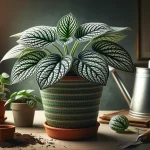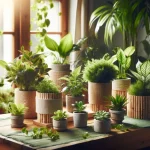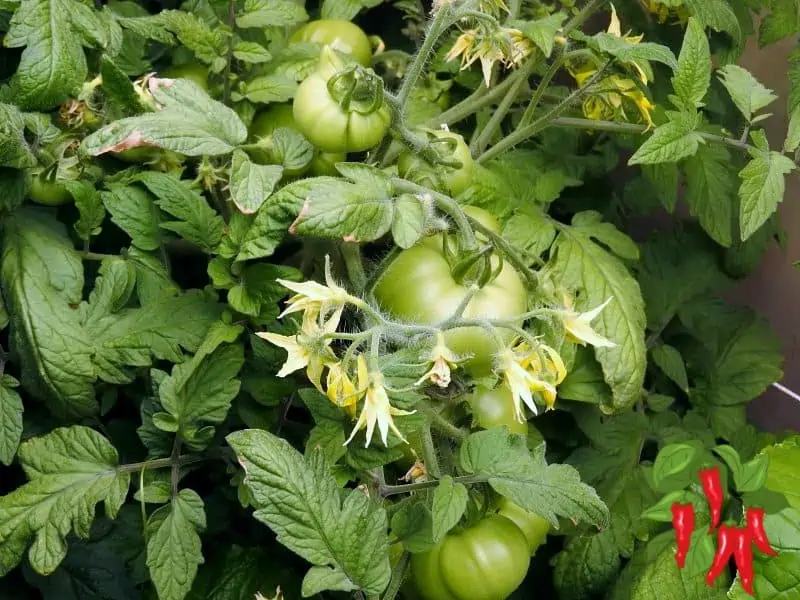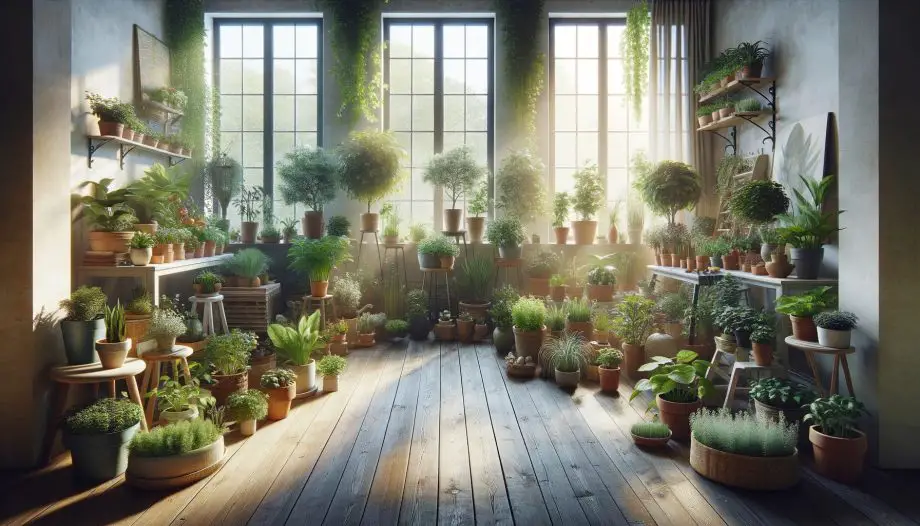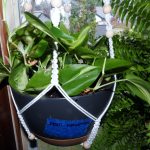This post may contain affiliate links. If you buy something from one of our links we may earn a commission. Thanks
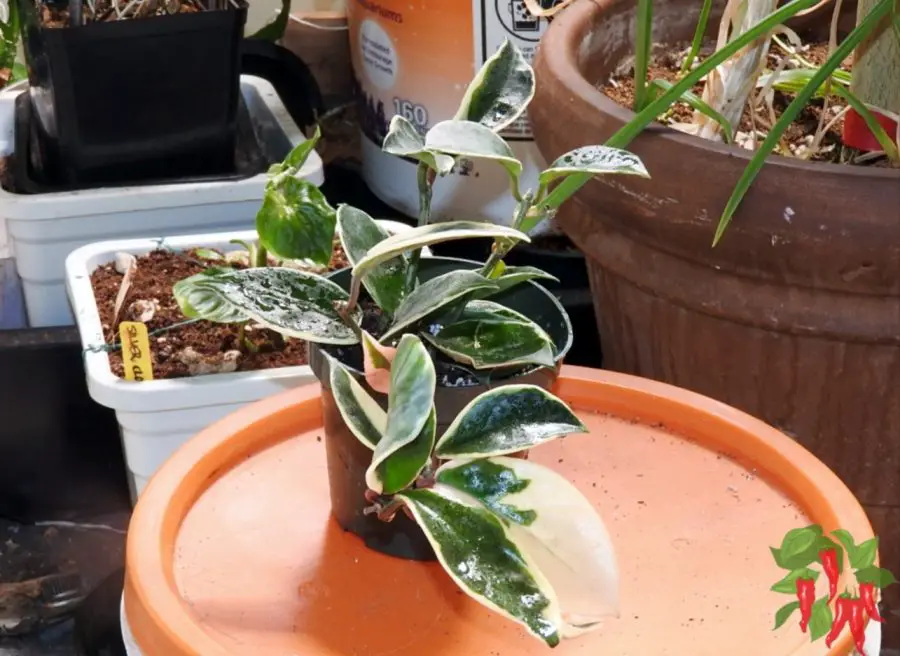
Discover simple Hoya Krimson Queen care tips to help your plant thrive! Learn everything from watering secrets to light requirements in this easy-to-follow guide.
Mastering Hoya Krimson Queen care doesn’t have to be complicated – but if you’ve ever watched your plant’s leaves turn yellow or struggled to get those gorgeous blooms, you’re not alone.
Many plant lovers find themselves second-guessing their care routine, wondering if they’re doing enough (or too much) for their beloved vine.
Well, I’m here to share all my tried-and-true tips that will help your Hoya flourish into a stunning showpiece with those eye-catching variegated leaves and sweet-smelling flowers.
Hoya Krimson Queen Care Key Takeaways:
- Hoya Krimson Queen care requires bright indirect light and well-draining soil.
- Water when the top inch of soil feels dry, typically every 7-10 days.
- Maintain temperatures between 60-85°F and humidity above 60%.
- Fertilize monthly during growing season
- Provide support for climbing or trailing growth.
How To Grow Krimson Queen Hoya Video
Hoya Krimson Queen or Sale
 Tricolor Hoya Krimson Queen, Hoya Carnosa Variegata Tricolor Hoya Ships from CA (4″ Pot)
Tricolor Hoya Krimson Queen, Hoya Carnosa Variegata Tricolor Hoya Ships from CA (4″ Pot)
Hoya Krimson Queen Care Guide
The Hoya Krimson Queen, also known as Hoya carnosa ‘Variegata’ or Tricolor Hoya, is a stunning houseplant that will catch everyone’s eye with its beautiful variegated leaves and sweet-smelling flowers.
Hoya carnosa, the porcelainflower or wax plant, is a species of flowering plant in the family Apocynaceae, native to East Asia. It is a common house plant grown for its attractive waxy foliage, and sweetly scented flowers. It is grown well in pots and hanging baskets. https://en.wikipedia.org/wiki/Hoya_carnosa
Originally from Eastern Asia and Australia, this climbing vine makes a perfect indoor plant when you know how to care for it properly.
Hoya carnosa Plant Care Reference Guide:
| Characteristic | Details |
|---|---|
| Common Name | Hoya carnosa, Wax Plant, Porcelain Flower |
| Botanical Name | Hoya carnosa |
| Native Habitat | Tropical and subtropical Asia and Australia |
| Plant Type | Perennial evergreen vine |
| Growth Pattern | Trailing or climbing with thick, waxy leaves |
| Mature Size | 2–4 feet indoors; larger with proper support and conditions |
| Watering | Allow the top 1–2 inches of soil to dry out between waterings |
| Light/Sun Exposure | Bright, indirect light; tolerates some direct morning sun |
| Soil Type | Well-draining potting mix; benefits from added orchid bark or perlite |
| Soil pH | Slightly acidic to neutral (6.0–7.0) |
| Temperature | 60–85°F (15–29°C); avoid temperatures below 50°F (10°C) |
| Humidity | Prefers moderate to high humidity but tolerates average indoor conditions |
| Bloom Time & Flower Color | Spring to summer; clusters of fragrant, star-shaped flowers in pink, white, or red |
| Potential Problems | Yellowing leaves (overwatering), leaf drop (low light), pests like mealybugs, aphids, or spider mites |
| Repotting | Every 2–3 years or when root-bound |
| Hardiness Zones (USDA) | Zones 10–12 (typically grown as a houseplant outside these zones) |
Krimson Queen Hoya Flowers
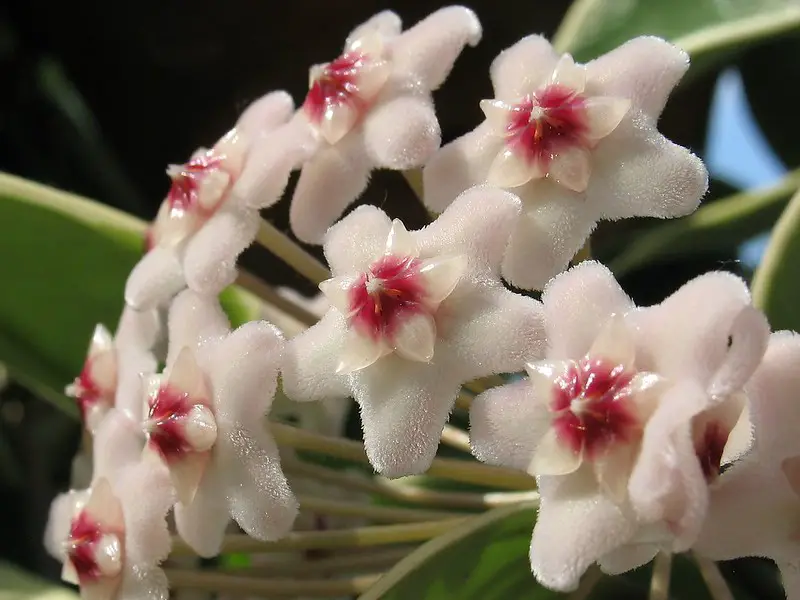
Hoya Krimson Queen vs. Hoya Krimson Princess
Let’s clear up the confusion between these two popular varieties:
• Krimson Queen has green leaves with creamy-white or pink edges
• Krimson Princess shows off green leaves with creamy-white or pink centers
 Hoya Crimson Princess – 4” from California Tropicals
Hoya Crimson Princess – 4” from California Tropicals
Light Requirements
Your Krimson Queen needs bright, indirect light to keep its gorgeous colors bright and vibrant.
An east-facing window works perfectly. Just keep it away from direct sun rays that could burn those beautiful leaves.
If you have a south-facing window you can hang some sheer curtains to filter the light or try placing it back several feet away.
Soil Preferences
Creating the perfect home for your Hoya’s roots is crucial for its success. Think of soil as your plant’s foundation – it needs to be just right to help your Hoya thrive.
Traditional Mix
A well-draining, airy potting mix is essential. Here’s a classic blend:
• 2 parts peat moss
• 1 part perlite
• 1 part orchid bark
The Coco Coir Advantage
Coco coir is becoming a favorite among Hoya growers, and for good reason:
• More sustainable than peat moss
• Better water retention while still maintaining airflow
• Naturally resistant to fungal growth
• pH neutral (peat is acidic)
• Rehydrates more easily than peat
• Lasts longer in pots
• Lighter weight
Perfect Perlite Ratio
Perlite is your Hoya’s best friend for these reasons:
• Creates essential air pockets
• Prevents soil compaction
• Improves drainage
• Lightweight and easy to mix
• Helps prevent root rot
Custom Soil Recipe
Try this modern mix for optimal growth:
• 50% coco coir
• 30% perlite
• 20% orchid bark
• Optional: Add a handful of worm castings for nutrients
Temperature and Humidity
Just like us, your Hoya has a comfort zone where it thrives best. Getting these two factors right can make the difference between a struggling plant and one that’s bursting with healthy growth and blooms.
Your Hoya will be happiest when:
• Temperature stays between 60°F and 85°F
• Humidity levels are 60% or higher
If your home is dry, try using a humidifier or set up a pebble tray with water underneath the plant.
Hoya Watering Guidelines
Water your Hoya when the top inch of soil feels dry. Give it a good drink, but make sure water can flow out the bottom of the pot.
Remember: it’s better to give your plant too little water than too much – these plants can bounce back from being dry but root rot from overwatering is much harder to fix.
Self-Watering Planters for Hoyas
Self-watering planters can be a game-changer for busy plant keepers, but they need to be used correctly with Hoyas.
Benefits
• Consistent moisture levels
• Reduced watering frequency
• Perfect for vacation care
• Less stress about underwatering
• Hanging planters wont drip on floors or furniture unless overfilled
Best Practices
• Choose containers with good drainage overflow
• Don’t fill the water reservoir completely
• Monitor soil moisture in the first few weeks
• Clean the reservoir monthly
Watch Out For
• Signs of overwatering
• Algae growth in reservoir
• Salt buildup in soil
• Root growth into water chamber
Setting Up Your Self-Watering Planter
• Use proper soil mix (more perlite than usual)
• Keep water level lower than recommended
• Check soil moisture before refilling
When to Avoid Self-Watering Pots
• For newly propagated plants
• During winter dormancy
• If your home is very humid
• When treating root issues
Remember: While self-watering planters can be convenient, they’re not a complete set-and-forget solution.
Your Hoya still needs regular checking and care adjustments based on season and growth patterns.
Propagation Methods
Want more Hoyas? Growing new plants from your existing one is easier than you might think.
Here’s how to turn one beautiful plant into many – perfect for growing your collection or sharing with friends.
Growing new plants is easy! Here’s how:
• Choose a healthy stem with at least two leaves and one node
• Let the cut end dry out for 24 hours (optional)
• Plant it in moist soil or put it in water
• Wait for roots to grow
• Move to a pot with well-draining soil once roots are established
Repotting Your Hoya Krimson Queen
Getting ready to give your Hoya a new home? Let’s walk through everything you need to know about repotting to keep your plant happy and healthy.
When to Repot
Look for these clear signs it’s time for a new pot:
• Roots peeking out of drainage holes
• Water runs straight through the pot
• Plant dries out every few days
• Growth has slowed despite good care
• Soil breaking down or becoming compact
Best Time for Repotting
Spring is your sweet spot for repotting because:
• Plant is entering active growth phase
• Roots recover faster
• Less risk of shock
• Stronger regrowth potential
Choosing the Right Pot
Select a container that’s:
• Just 1-2 inches larger than current pot
• Has plenty of drainage holes
• Made of terracotta or plastic (both work well)
• Not too deep – Hoyas prefer being snug
Step-by-Step Repotting Guide
1. Gather Your Supplies:
• Fresh potting mix
• Clean pot
• Clean scissors
• Gloves
• Support stake (optional)
2. Remove Plant:
• Water lightly the day before
• Gently squeeze pot sides
• Turn sideways and ease plant out
• Don’t pull by stems
3. Check Roots:
• Remove old soil gently
• Trim any dead or rotted roots
• Untangle if root-bound
• Look for healthy white roots
4. Prepare New Pot:
• Add drainage layer
• Put in fresh soil mix
• Make center hole for roots
5. Replant:
• Position at same depth as before
• Fill around roots carefully
• Tap pot to remove air pockets
• Add support if needed
After-Repotting Care
• Wait a week before watering
• Keep out of direct sun
• Skip fertilizer for a month
• Maintain higher humidity
• Expect some adjustment period
Common Repotting Mistakes
• Going too big with pot size
• Repotting during dormancy
• Breaking up roots too much
• Packing soil too tightly
• Immediate fertilizing
Pro Tips
• Save some old soil to mix with new
• Sanitize pots before reusing
• Take photos before removing plant
• Have support ready if needed
• Consider propagating while repotting
Remember: Hoyas actually like being a bit root-bound and will often bloom better this way.
Don’t rush to repot unless you see clear signs it’s needed. When in doubt, wait it out!
Hoya Krimson Queen Maintenance
Keeping your Hoya happy isn’t about daily fussing. It’s about understanding a few key care routines.
Let’s look at the simple maintenance tasks that will keep your plant healthy and gorgeous year after year.
Keep your plant looking its best by:
• Removing any dead or yellow leaves
• Feeding it monthly with balanced fertilizer during growing season
• Repotting every 2-3 years in spring
Troubleshooting Common Hoya Problems
Even the healthiest Hoyas can hit a rough patch sometimes. Don’t worry – most issues have simple solutions.
Here’s your guide to spotting problems early and getting your plant back to its beautiful self.
Yellowing Leaves
• Cause: Usually overwatering or poor drainage
• Solution: Check root health, reduce watering, and ensure soil drains well
Dropping Leaves
• Cause: Temperature shock or drafts
• Solution: Move plant away from AC vents, heaters, and cold windows
Loss of Variegation
• Cause: Insufficient light
• Solution: Move to a brighter location, but avoid direct sun
Brown Crispy Edges
• Cause: Low humidity or mineral buildup from tap water
• Solution: Increase humidity and consider using filtered water
No Blooms
• Cause: Not enough light or disturbing the plant too much
• Solution: Provide consistent bright indirect light and avoid moving the plant
Seasonal Care Adjustments
Your Hoya’s needs change with the seasons, just like our wardrobe does. Understanding these seasonal shifts will help you adjust your care routine at just the right time.
Spring (Growing Season)
• Start fertilizing monthly
• Increase watering as growth picks up
• Perfect time for propagation
• Clean leaves and check for pests
Summer
• Protect from hot afternoon sun
• Increase humidity
• Watch for signs of heat stress
• Can water more frequently
Fall
• Reduce fertilizing
• Begin decreasing water
• Move away from cooling windows
• Last chance for pruning before winter
Winter
• Water less frequently
• Stop fertilizing
• Maintain temperature above 60°F
• Keep away from cold drafts
• Don’t worry if growth slows – it’s normal
Decorating With Hoyas
Ready to show off your beautiful Hoya? These versatile plants can transform any space from ordinary to extraordinary. Let’s explore creative ways to display your plant while ensuring it gets everything it needs to thrive.
Hoyas are versatile plants that can enhance any room’s style. Here’s how to showcase them:
Hanging Displays
• Use macramé hangers for a boho look
• Place in hanging baskets near windows
• Let vines cascade down bookshelves
Climbing Displays
• Train vines up decorative trellises
• Use command hooks to create living walls
• Guide around window frames for natural curtains
Shelf Styling
• Place among books for a lived-in look
• Group with other plants for a jungle vibe
• Use different pot heights for visual interest
Design Tips
• Choose pots that complement your decor style
• Consider plant placement in relation to other furnishings
• Use Hoyas as natural room dividers
• Create focal points with multiple plants at different heights
Best Rooms for Hoyas
• Bathrooms: Natural humidity makes them thrive
• Kitchens: Can handle occasional temperature changes
• Living Rooms: Perfect for showing off their beauty
• Home Offices: Adds life without taking up desk space
Remember to always consider light conditions first when choosing a spot for your Hoya.
Even the most beautiful decorative placement won’t work if the plant can’t get the light it needs to thrive.
Hoya Krimson Queen Frequently Asked Questions
We’ve gathered the most common questions about Hoya plants that indoor gardeners ask about caring for their Hoya Krimson Queen.
Q: How often should I water my Krimson Queen?
A: Water your Krimson Queen when the top inch of soil feels dry to the touch. In most homes, this means watering every 7-10 days but always check the soil first rather than following a strict schedule. Your plant will need more water in summer and less in winter.
Q: What’s the ideal light situation for a Hoya Krimson Queen?
A: Bright, indirect light is perfect – think morning sun or filtered light throughout the day. An east-facing window is ideal, or a few feet back from a south-facing window. You’ll know your plant is getting good light when the variegation stays bright and crisp.
Q: Does a Hoya Krimson Queen grow quickly?
A: During spring and summer, expect steady but moderate growth with new leaves appearing every few weeks. Growth slows considerably in fall and winter. Don’t worry if your plant seems to take a break – this is completely normal.
Q: Should my Hoya climb or trail?
A: Both! In nature, they climb up trees, but in homes, they’re gorgeous either way. For climbing, provide a trellis or moss pole. For trailing, use a hanging basket or high shelf. Just choose one style and stick with it – changing direction can stress the plant.
Q: Which room is best for my Hoya?
A: An east-facing window is perfect. Bathrooms with good light work well because of the humidity. Any room can work as long as you have bright, indirect light and can maintain temperatures between 60-85°F.
Q: What size pot works best?
A: Choose a pot just 1-2 inches larger than the root ball. Hoyas actually bloom better when slightly root-bound. Always ensure excellent drainage – the pot size matters less than having plenty of drainage holes.
Q: Should I add a support stake?
A: It’s your choice! Stakes or trellises help create a more upright, compact plant. If you want a bushier look, stake it. If you prefer a cascade of vines, skip the stake. Either way, your plant will be healthy.
Q: Is it okay if my Hoya is crowded in its pot?
A: Yes! Hoyas actually prefer being somewhat root-bound and often bloom better this way. Don’t rush to repot unless you see roots growing out of drainage holes or the plant is drying out very quickly.
Q: Does misting help my Hoya?
A: Skip the misting – it can actually cause problems like leaf spots. Instead, use a humidity tray or humidifier if your air is dry. Good air circulation is more important than misting.
Q: How can I make my Hoya fuller?
A: Prune the growing tips when vines get leggy. Each cut will encourage branching, creating a bushier plant. Do this in spring or summer when the plant is actively growing.
Q: When’s the right time to repot?
A: Repot in spring every 2-3 years, or when your plant becomes severely root-bound. Signs it’s time include: roots circling the bottom of the pot, very quick soil drying, or slowed growth despite good care.
Q: Do Hoyas need fertilizer?
A: Feed monthly during growing season (spring through summer) with a balanced, water-soluble fertilizer diluted to half strength. Stop fertilizing in fall and winter when growth naturally slows.
Q: How can I tell if my plant is getting enough light?
A: Look at the variegation – if it’s bright and clear, your plant is happy. If leaves look dull or are turning all green, it needs more light.
Q: My Hoya isn’t growing – what’s wrong?
A: Growth slows down in winter, which is normal. If it’s growing season and you’re not seeing new leaves, check your light levels and make sure you’re not overwatering.
Q: When will my Hoya bloom?
A: Patience is key! Plants typically need to be mature (2-3 years old) and slightly root-bound to bloom. Consistent care and bright indirect light help encourage flowering.
Q: Is my Hoya toxic to pets?
A: Good news – Hoyas are non-toxic to cats and dogs, making them a safe choice for pet owners.
Conclusion
Growing a Hoya Krimson Queen is a rewarding journey that gets easier once you understand the basics. Whether you’re a new green thumb or looking to level up your care game, these tips will help your Hoya thrive.
Growing a Healthy Hoya
With the right care, your Hoya Krimson Queen can become a stunning addition to your home. Focus on these key areas:
- Light Management
Position your plant carefully and adjust based on leaf appearance and growth. - Watering Routine
Develop a consistent checking schedule rather than watering on set days. - Growth Support
Decide whether you want your plant to climb or trail and provide appropriate support early on.
Key Takeaways
• Less water is better than too much water
• Bright indirect light is crucial for variegation
• Higher humidity leads to happier plants
• Root-bound plants are more likely to bloom
• Regular pruning encourages bushy growth
• Temperature stability matters more than exact numbers
• Patience is important – these plants grow moderately
By following these guidelines, you’ll be well on your way to growing a beautiful, healthy Hoya Krimson Queen that can become a long-lasting part of your indoor garden.
Learn more: Indoor Apartment Gardening: 15 Point Comprehensive Guide
Visit my Amazon Influencer Page for videos and gardening products Grow Your Own Garden

